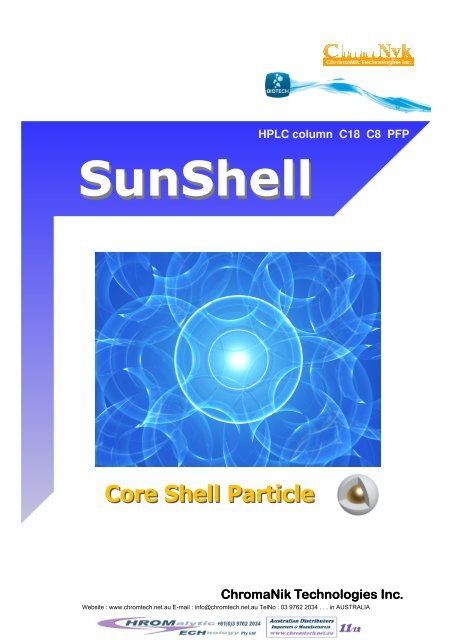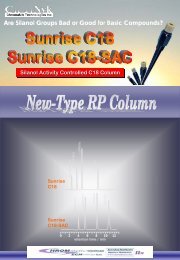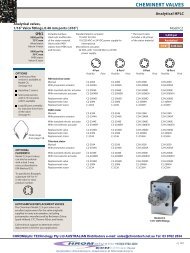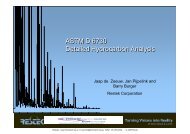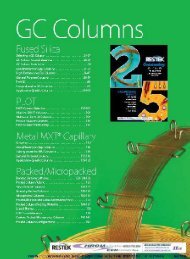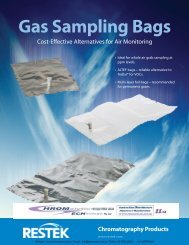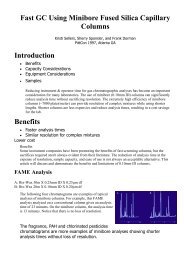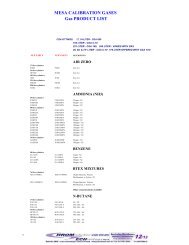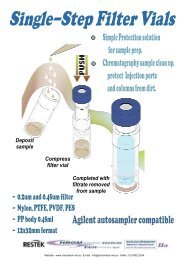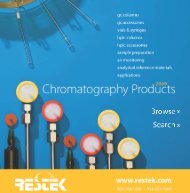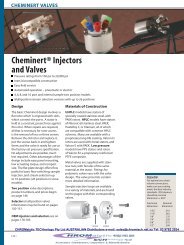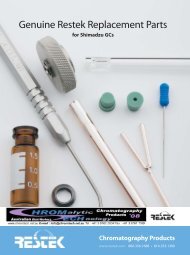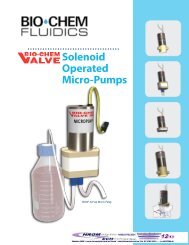Core-Shell
Core-Shell
Core-Shell
Create successful ePaper yourself
Turn your PDF publications into a flip-book with our unique Google optimized e-Paper software.
HPLC column C18 C8 PFPSun<strong>Shell</strong><strong>Core</strong> <strong>Shell</strong> ParticleChromaNik Technologies Inc.Website : www.chromtech.net.au E-mail : info@chromtech.net.au TelNo : 03 9762 2034 . . . in AUSTRALIA
“Sun<strong>Shell</strong> “ is a core shell silica column made by ChromaNIk Technologies.The next generation to <strong>Core</strong> <strong>Shell</strong> particleFeatures of Sun<strong>Shell</strong>*1.6 µm of core and 0.5 µm of superficially porous silica layer*Same efficiency and high throughput as a Sub 2µm particle*Same pressure as a 3 µm particle (less than a half then a sub 2µm particle)*Same chemistry as Sunniest technology (reference figure 1)*Good peak shape for all compounds such as basic, acidic andchelating compounds*High stability ( pH range for Sun<strong>Shell</strong> C18, 1.5 to 10)* Low breeding2.6 µm<strong>Core</strong>0.5 µmµm<strong>Core</strong>1.6 µmPorous silica0.5Schematic diagram of a core shell silica particle2.6 µmSuperficially porous silicaSi OOO OSiSi Si SiO SiO SiSi OO OSi OOSiOOSiSiSiOO O SiOO O O OSiOO OSiO OOSiOHOOSiOSiOHOOSiOSiSiOSiOOOSiOSiOFinal TMSSiSiOOSiOSiO OH OO OSi Si SiOO O OOSiO O SiOSchematic diagram of bonding of Sun<strong>Shell</strong> C18OSiOOOHVan Deemter EquationA term : Eddy diffusion(dp is particle diameter)B term : Longitudinal diffusion(Dm is diffusion coefficient)C term : Mass transferB termA termVan Deemter plotuC termHETP, µm m181614121086420Comparison of plate height plotsFully porous 5 umFully porous 3 um0 5 10 15Mobile phase velocity, mm/secFully proous 1.8 umSun<strong>Shell</strong> 2.6 umFully porous 2.6 umColumn: C18, 50 x 4.6 mm C18Mobile phase: Acetonitrile/water=(60/40)Temperature: 25 o CSample : NaphthaleneBack pressure, MPa4540353025201510500 0.5 1 1.5Flow rate, mL/minSunniest C18-HT 2.0 umBrand A C18 1.9 umBrand B C18 1.8 umBrand C C18 1.7 umBrand D C18 2.6 umSun<strong>Shell</strong> C18 2.6 umColumn dimension: 50 x 2.1 mmMobile phase: Acetonitrile/water=(70/30)Temperature: 25 o CComparison of back pressure for high throughput columnsSun<strong>Shell</strong> C18 shows same efficiency as a sub 2 µmC18. In comparison between fully porous 2.6 µm andcore shell 2.6 µm (Sun<strong>Shell</strong>), Sun<strong>Shell</strong> shows lowervalues for A term, B term and C term of Van Deemterequation. The core shell structure leads higherperformance to compare with the fully porous structure.Furthermore back pressure of Sun<strong>Shell</strong> C18 is lessthan a half to compare with sub-2 µm C18s.Website : www.chromtech.net.au E-mail : info@chromtech.net.au TelNo : 03 9762 2034 . . . in AUSTRALIA
Wide particle distribution (Conventional silica gel D 90 /D 10 =1.50)Narrow particle distribution (core shell silicaD 90 /D 10 =1.15)Why does a 2.6 µm core shell particle show the same performanceas a sub 2 µm particle?Company F, 2 µmD 10 : 1.67 µmD 50 : 2.09 µmD 90 : 2.65 µmD 90 /D 10 =1.59Sunniest, 2 µmD 10 : 1.75 µmD 50 : 2.01 µmD 90 : 2.31 µmD 90 /D 10 =1.32Sun<strong>Shell</strong>, 2.6 µmD 10 : 2.46 µmD 50 : 2.63 µmD 90 : 2.82 µmD 90 /D 10 =1.15Flow of mobile phase0.5 10.5 2 (µm) 4Comparison of Particle Size DistributionPacking state of core shell and fully porous silicaThe size distribution of a core shell (Sun<strong>Shell</strong>) particle is much narrower than that of a conventional fully porousparticle, so that the space among particles in the column reduces and efficiency increases by reducing EddyDiffusion (multi-path diffusion) as the A term in Van Deemter Equation.As shown in the left figure, a coreshell particle has a core so that thediffusion path of samples shortensand mass transfer becomes fast.This means that the C term in VanDeemter Equation reduces. In otherwords, HETP (theoretical plate) iskept even if flow rate increases.A 2.6 µm core shell particle showsas same column efficiency as a fullyporous sub-2 µm particle.DiffusionCa. 2.0 µmsampleSampleemanates in aparticle after itenters.Diffusion2.0 µmsampleComparison of diffusion pathThe right figure shows that adiffusion width of a sample in a 2.6µm core shell particle and a 2 µmfully porous particle. Both diffusionwidths are almost same. The 2.6 µmcore shell particle is superficiallyporous, so that the diffusion widthbecomes narrower than particlesize. Same diffusion means sameefficiency.1.6 µm2.6 µm2.0 µm<strong>Shell</strong>Diffusion of sample in core shell and fully porous silica<strong>Core</strong>porous TotallyComparison of Performance by Plate/Pressurepress.Plate Back press. (MPa) Plate/backSunniest C18 –HT 2.0 µm 9,900 16.7 593Brand A C18 1.9 µm 7,660 16.3 470Brand B C18 1.8 µm 10,100 19.6 515Brand C C18 1.7 µm 11,140 32.0 348Sun<strong>Shell</strong> C18 2.6 µm 9,600 9.7 990Under a constant back pressurecondition, Sun<strong>Shell</strong> C18 showedmore than 2 times higherperformance to compare with fullysub-2µm porous C18s.Sunniest C18 –HT 2.0 µmBrand A C18 1.9 µmBrand B C18 1.8 µmBrand C C18 1.7 µmSun<strong>Shell</strong> C18 2.6 µmColumn: 50 x 2.1 mm C18, Mobile phase: Acetonitrile/water=(70/30), Temperature: 25 o CWebsite : www.chromtech.net.au E-mail : info@chromtech.net.au TelNo : 03 9762 2034 . . . in AUSTRALIA
Characteristics of Sun<strong>Shell</strong> C18Particle size(µm)<strong>Core</strong> shell silicaPore diameter(nm)Specific surface area(m 2 /g)Carbon content(%)BondedphaseC18Maximum operatingpressureAvailable pHrangeSun<strong>Shell</strong> C18 2.6 9 150 7 C18 60 MPa or 8,570 psi 1.5 - 10Comparison of standard samples between core shell C18s23123145647Brand D C18 (<strong>Core</strong> shell)756Brand E C18 (<strong>Core</strong> shell)Column:Brand D C18, 2.6 µm 150 x 4.6 mm (<strong>Core</strong> shell type)Brand E C18, 2.7 µm 150 x 4.6 mm (<strong>Core</strong> shell type)Sun<strong>Shell</strong> C18, 2.6 µm 150 x 4.6 mmMobile phase: CH 3 OH/H 2 O=75/25Flow rate: 1.0 mL/minTemperature: 40 º CSample: 1 = Uracil, 2 = Caffeine, 3 = Phenol, 4 = Butylbenzene5 = o-Terphenyl, 6 = Amylbenzene, 7 = Triphenylene213Sun<strong>Shell</strong> C18 (core shell)4567Hydrogen bonding(Caffeine/Phenol)Hydrophobicity(Amylbenzene/Butylbenzene)Steric selectivity(Triphenylene/o-Terphenyl)Brand D C18 0.48 1.54 1.20Brand E C18 0.44 1.60 1.310 2 4 6 8 10 12 14 16 18 20 22 24Retention time/minSun<strong>Shell</strong> C18 0.40 1.59 1.47Retention of standard samples was compared for three kinds of core shell type C18s. Brand D C18 showed only a half retention tocompare with Sun<strong>Shell</strong> C18. Steric selectivity becomes large when ligand density on the surface is high. Sun<strong>Shell</strong> C18 has thelargest steric selectivity so that it has the highest ligand density. This leads the longest retention time.Comparison of pyridine Comparison of Oxine Comparison of formic acidBrand D C18(<strong>Core</strong> shell)123Brand D C18(<strong>Core</strong> shell)12123Brand D C18(<strong>Core</strong> shell)Brand E C18(<strong>Core</strong> shell)123Brand E C18(<strong>Core</strong> shell)12123Brand E C18(<strong>Core</strong> shell)Sun<strong>Shell</strong> C18(<strong>Core</strong> <strong>Shell</strong>)12 3Sun<strong>Shell</strong> C18(<strong>Core</strong> shell)12123Sun<strong>Shell</strong> C18(<strong>Core</strong> shell)0 1 2 3 4 5 6 7Retention time/minColumn:Brand D C18, 2.6 µm 150 x 4.6 mmBrand E C18, 2.7 µm 150 x 4.6 mmSun<strong>Shell</strong> C18, 2.6 µm 150 x 4.6 mmMobile phase: CH 3 OH/H 2 O=30/70Flow rate: 1.0 mL/minTemperature: 40 ºCDetection: UV@250nmSample: 1 = Uracil2 = Pyridine3 = Phenol8 9 10 11 12 130 1 2 3 4 5 6Retention time/minColumn:Brand D C18, 2.6 µm 150 x 4.6 mmBrand E C18, 2.7 µm 150 x 4.6 mmSun<strong>Shell</strong> C18, 2.6 µm 150 x 4.6 mmMobile phase: CH 3 CN/20mM H 3 PO 4 =10/90Flow rate: 1.0 mL/minTemperature: 40 ºCDetection: UV@250nmSample: 1 = 8-Quinolinol (Oxine)2 = Caffeine0 1 2 3 4 5 6Retention time/min7 8 9 10Column:Brand D C18, 2.6 µm 150 x 4.6 mmBrand E C18, 2.7 µm 150 x 4.6 mmSun<strong>Shell</strong> C18, 2.6 µm 150 x 4.6 mmMobile phase: CH 3 CN/0.1% H 3 PO 4 =2/98Flow rate: 1.0 mL/minTemperature: 40 ºCDetection: UV@210nmSample: 1 = Formic acid2 = Acetic acid3 = Propionic AcidResidual silanol groups make pyridine betailing under methanol/water mobile phasecondition. Only Sun<strong>Shell</strong> C18 shows asharp peak for pyridine.8-Quinolinol (Oxine) is a metal chelatingcompound. Metal impurities in the coreshell particle leads the tailing for oxinepeak.Formic acid is used as an indicator for aacidic inertness. Sun<strong>Shell</strong> and brand DC18 show a sharp peak.Website : www.chromtech.net.au E-mail : info@chromtech.net.au TelNo : 03 9762 2034 . . . in AUSTRALIA
Loading capacity of amitriptyline as a basic compoundAmitriptyline overlords much more at acetonitrile/buffer mobile phase than methanol/buffer. Three kinds of core shell C18s werecompared loading capacity of amitriptyline at three different mobile phases.Common condition: Column dimension,150 x 4.6 mm, flow rate; 1.0 mL/min, temperature; 40 o CMobile phase: Acetonitrile/20mM phosphate buffer pH7.0=(60:40)Mobile phase: Acetonitrile/10mM acetate ammonium pH6.8=(40:60)100 times30 times1 23 4Sun<strong>Shell</strong> C181 2 3 4Brand D C18Sample:1 = Uracil (0.07µg)2 = Propranolol (1.53µg)3 = Nortriptyline (0.32µg)4 = Amitriptyline (0.32µg)112432 3 4Sun<strong>Shell</strong> C18Brand D C181 2 3 4Brand E C181324Brand E C180 1 2 3 4 5 6 7 8 9 10Retention time/minTheoretical plate was calculated by 5σ methodusing peak width at 4.4% of peak height.4.4%0 1 2 3 4 5 6 7 8 9 10Retention time/minMobile phase: Acetonitrile/0.1% formic acid=(30:70)USP tailing factor3.62.92.47 times1.81.34 6Amitriptyline overloads at low weightwhen acetonitrile/0.1% formic acidmobile phase. A peak is shiftedforward under overloading.Brand D C18 overloaded at more than 0.01 µg of amitriptyline while Sun<strong>Shell</strong> C18 overloadsed at more than from 0.3 to 1 µg of amitriptyline.Surprisingly loading capacity of Brand D C18 was only one hundredth to compare with Sun<strong>Shell</strong> C18 under acetonitrile/20mM phosphate bufferpH7.0=(60:40) mobile phase. Brand E C18 always showed poor peak of amitriptyline.Website : www.chromtech.net.au E-mail : info@chromtech.net.au TelNo : 03 9762 2034 . . . in AUSTRALIA
◆Evaluation of StabilityAccelerated acidic testAlkaline test1% TFA80 ºCpH1050 ºCDurable test conditionColumn size: 50 x 2.1 mmMobile phase: CH 3 CN/1.0% TFA, pH1=10/90Flow rate: 0.4 mL/minTemperature: 80 ºCMeasurement conditionColumn size: 50 x 2.1 mmMobile phase: CH 3 CN/H 2 O=60/40Flow rate: 0.4 mL/minTemperature: 40 ºCSample: 1 = Uracil (t 0 )2 = ButylbenzeneStability under acidic pH condition was evaluated at 80 ºC usingacetonitrile/1% trifluoroacetic acid solution (10:90) as mobilephase. 100% aqueous mobile phase expels from the pore ofpacking materials by capillarity and packing materials doesn’tdeteriorate. 10% acetonitrile in a mobile phase allows anaccurate evaluation. 1-3)★Sunshell C18 has kept 90% retention for 100hours under such a severe condition. Sun<strong>Shell</strong>C18 is 5 to 10 times more stable than the othercore shell C18.1) N. Nagae, T. Enami and S. Doshi, LC/GC North America October 2002.2) T. Enami and N. Nagae, American Laboratory October 2004.3) T. Enami and N. Nagae, BUNSEKI KAGAKU, 53 (2004) 1309.Durable test conditionColumn Size: 50 x 2.1 mmMobile phase:CH 3 OH/20mM Sodium borate/10mM NaOH=30/21/49 (pH10)Flow rate: 0.4 mL/minTemperature: 50 ºCMeasurement conditionColumn Size: 50 x 2.1 mmMobile phase: CH 3 CN/H 2 O=60/40Flow rate: 0.4 mL/minTemperature: 40 ºCSample: 1 = ButylbenzeneStability under basic pH condition was evaluated at 50 ºC usingmethanol/Sodium borate buffer pH 10 (30:70) as mobile phase.Sodium borate is used as a alkaline standard solution for pHmeter, so that its buffer capacity is high.Elevated temperature of 10 ºC makes column life be one third.The other company shows stability test at ambient (roomtemperature). If room temperature is 25 ºC, column life at roomtemperature (25 ºC) is sixteen times longer than that at 50 ºC.★Sun<strong>Shell</strong> C18 is enough stable even if it is usedunder pH 10 condition. Regarding stability underbasic pH condition, there is little C18 column likeSun<strong>Shell</strong> C18 except for hybrid type C18. It isconsidered that our end-capping technique leadshigh stability.★ Sun<strong>Shell</strong> C18 can be used at the pHrange from 1.5 to 10.Website : www.chromtech.net.au E-mail : info@chromtech.net.au TelNo : 03 9762 2034 . . . in AUSTRALIA
Particle size(µm)<strong>Core</strong> shell silicaPore diameter(nm)Specific surfacearea (m 2 /g)Sun<strong>Shell</strong> の 基 本 特 性Sun<strong>Shell</strong> C8, PFP(Pentafluorophenyl)PFP◆ Characteristics of Sun<strong>Shell</strong>Carbon content(%)Bonded phaseBonded phaseMaximum operatingpressureAvailable pHrangeSun<strong>Shell</strong> C18 2.6 9 150 7 C18 60 MPa or 8,570 psi 1.5 - 10Sun<strong>Shell</strong> C8 2.6 9 150 4.5 C8 60 MPa or 8,570 psi 1.5 - 9Sun<strong>Shell</strong> PFP 2.6 9 150 4.5 Pentafluorophenyl 60 MPa or 8,570 psi 2 - 8◆ Comparison of standard samples112,32356447756Sun<strong>Shell</strong> PFPSun<strong>Shell</strong> C8Column:Sun<strong>Shell</strong> PFP, 2.6 µm 150 x 4.6 mmSun<strong>Shell</strong> C8, 2.6 µm 150 x 4.6 mmSun<strong>Shell</strong> C18, 2.6 µm 150 x 4.6 mmMobile phase: CH 3 OH/H 2 O=75/25Flow rate: 1.0 mL/minTemperature: 40 ºCSample: 1 = Uracil, 2 = Caffeine, 3 = Phenol, 4 = Butylbenzene5 = o-Terphenyl, 6 = Amylbenzene, 7 = Triphenylene123Sun<strong>Shell</strong> C184567Hydrogen bonding(Caffeine/Phenol)Hydrophobicity(Amylbenzene/Butylbenzene)Steric selectivity(Triphenylene/o-Terphenyl)Sun<strong>Shell</strong> PFP 1.00 1.31 2.38Sun<strong>Shell</strong> C8 0.32 1.46 1.080 2 4 6 8 10 12 14 16 18 20 22 24Retention time/minSun<strong>Shell</strong> C18 0.39 1.60 1.46Retention of standard samples was compared for three kinds of phases such as C18, C8 and PFP. C18 showed the highesthydrophobicity and PFP showed both the highest steric selectivity and the highest hydrogen bonding. The feature of PFP phase isto have hydrogen bonding, dipole-dipole interaction, aromatic and pi-pi interactions and hydrophobicity, which causes a differentselectivity from a C18 phase.Separation of amitriptyline using C8 Separation of xanthines Separation of isomers of xylene34Sun<strong>Shell</strong>C181 234WaterSun<strong>Shell</strong> C1812312Sun<strong>Shell</strong>PFP1 2 34Water30 1 2 3 4 5Retention time/minSun<strong>Shell</strong> C8, 2.6 µm 150 x 4.6 mmMobile phase:CH 3 CN/20mM phosphate buffer H7.0=60/40Flow rate: 1.0 mL/minTemperature: 40 ºCDetection: UV@250nmSample: 1 = Uracil2 = Propranolol3 = Nortriptyline4 = AmitriptylineSun<strong>Shell</strong>PFPSun<strong>Shell</strong>PFP1 2120mMphosphatebuffer pH750mMphosphatebuffer pH70 1 2 3 4 5Retention time/minSun<strong>Shell</strong> C18, PFP 2.6 µm 150 x 2.1 mmMobile phase: CH 3 OH/water or buffer=30/70Flow rate: 0.3 mL/minTemperature: 25 ºCDetection: UV@250nmSample: 1 = Theobromine2 = Theophyline3 = Caffeine4 = Phenol42 343Sun<strong>Shell</strong> PFP0 1 2 3 4 5Retention time/minSun<strong>Shell</strong> C18, PFP 2.6 µm 150 x 2.1 mmMobile phase:CH 3 OH/water=75:25 for Sun<strong>Shell</strong> C18CH 3 OH/water=60:40 for Sun<strong>Shell</strong> PFPFlow rate: 0.3 mL/minTemperature: 25 ºCDetection: UV@250nmSample: 1 = o-Xylene2 = m-Xylene3 = p-Xylene12Sun<strong>Shell</strong> C8 showed a sharp peak foramitriptyline a well as Sun<strong>Shell</strong> C18.Sun<strong>Shell</strong> PFP can retain xanthines more thanSun<strong>Shell</strong> C18. The higher the concentration ofSun<strong>Shell</strong> PFP showed the different selectivityfrom Sun<strong>Shell</strong> C18.Website : www.chromtech.net.au buffer, E-mail the : longer info@chromtech.net.au the retention time. TelNo : 03 9762 2034 . . . in AUSTRALIA
Efficiency of Sun<strong>Shell</strong> C18UHPLCColumn: Sun<strong>Shell</strong> C18, 50 x 2.1 mm3Plate(3)=10,3001240 1 2 3 4 5Retention time/minColumn: Sun<strong>Shell</strong> C18, 100 x 2.1 mm31 2Plate(3)=21,3004Column: Sun<strong>Shell</strong> C18, 2.6 µm 50 x 2.1 mmMobile phase: CH 3 CN/H 2 O=60/40Flow rate: 0.3 mL/minPressure: 7 MPaTemperature: 23 ºCSample: 1 = Uracil2 = Toluene3 = Acenaphthene4 = ButylbenzeneColumn: Sun<strong>Shell</strong> C18, 2.6 µm 100 x 2.1 mmMobile phase: CH 3 CN/H 2 O=60/40Flow rate: 0.3 mL/minPressure: 12.5 MPaTemperature: 25 ºC0 2 4 6 8Retention time/minColumn: Sun<strong>Shell</strong> C18,150 x 4.6 mmEfficiency=253,000 plate/m1120 2 4 6 8 10Retention time/minColumn: Sun<strong>Shell</strong> C18, 150 x 4.6 mm32Plate(3)=38,00034Plate(3)=31,0004HPLC80% efficiency tocompare with UHPLCColumn: Sun<strong>Shell</strong> C18, 2.6 µm 150 x 4.6 mmSun<strong>Shell</strong> C18, 2.6 µm 100 x 4.6 mmMobile phase: CH 3 CN/H 2 O=70/30Flow rate: 1.0 mL/minPressure: 14.5MPa(UHPLC),13.5 MPa(HPLC) for 150 mm9.5MPa(HPLC) for 100 mmTemperature: 25 ºCSample: 1 = Uracil2 = Toluene3 = Acenaphthene4 = Butylbenzene1Column: Sun<strong>Shell</strong> C18, 100 x 4.6 mm23Plate(3)=20,00040 2 4 6 8 10Retention time/min0 2 4 6 8 10Retention time/minLaChrom ELITEThe same efficiency as5 µm, 250 x 4.6 mmSaving 60% foranalytical time andconsumption of solventWebsite : www.chromtech.net.au E-mail : info@chromtech.net.au TelNo : 03 9762 2034 . . . in AUSTRALIA
Examples of transfer from a conventional 5 µm column to Sun<strong>Shell</strong> columnIsocratic separationHPLC12311/3 of analysis time0 2 4 6 8 10 12 14 16 18 20 22 24Retention time/minN(4)=20,2871Sun<strong>Shell</strong> C18, 2.6 µm 100 x 4.6 mm452233ACE C18, 5 µm 250 x 4.6 mm0 1 2 3 4 5 6Retention time/min44N(4)=19,3135N(4)=20,2875Column:ACE C18, 5 µm 250 x 4.6 mmSun<strong>Shell</strong> C18, 2.6 µm 100 x 4.6 mmMobile phase:CH 3 CN/20mM Phosphoric acid = 45/55Flow rate: 1.0 mL/min,1.8 mL/min at the lowest chromatogramTemperature: 25 ºCPressure: 9.5 MPa for ACE C18 5 µm13.4 MPa for Sun<strong>Shell</strong> C18 2.6 µmDetection: UV@230 nmSample: 1 = Benzydamine2 = Ketoprofen3 = Naproxen4 = Indomethacin5 = IbuprofenUHPLC1231.0 mL/min4N(4)=24,1245HPLC: Hitachi LaChrom ELITE (using 0.25 mm i.d. tubing)UHPLC: Jasco X-LC123451.8 mL/minN(4)=22,424Analysis time decreases to 1/6 to comparewith a 5 µm column sized 250 x 4.6 mm.0 1 2 3 4 5 6Retention time/minGradient separationHPLC140 2 4 6 8 10 12 14 16 18 20 22 24Retention time/min12Sunniest C18, 5 µm 150 x 4.6 mm340 1 2 3 4 5 6Retention time/min152Sun<strong>Shell</strong> C18, 2.6 µm 75 x 4.6 mm6728 93341/2 of Analysis time5656778 98 97 8 9Column:Sunniest C18, 5 µm 150 x 4.6 mmSun<strong>Shell</strong> C18, 2.6 µm 75 x 4.6 mmMobile phase:A) 0.1% Phosphoric acidB) CH 3 CNGradient program for Sunniest C18for Sun<strong>Shell</strong> C18Time 0 min 15 min 20 min%B 2% 25% 25%Time 0 min 7.5 min 10 min%B 2% 25% 25%Flow rate: 1.0 mL/min,Temperature: 25 ºCDetection: UV@250 nmSample: Oolong tea1 = Gallocatechin, 2 = Epigallocatechin,3 = Catechin, 4 = Caffeine, 5 = Epicatechin,6 = Epigallocatechin gallate, 7 = Gallocatechingallate, 8 = Epicatechin gallate, 9 = Catechin gallateUHPLC120 1 2 3 4 5 6Retention time/min345678 9HPLC: Hitachi LaChrom ELITE (using 0.25 mm i.d. tubing)UHPLC: Jasco X-LCThere are difference of system time lagbetween HPLC and UHPLC. UHPLC has muchless system time lag than HPLC because of highpressure gradient system for UHPLC and lowpressure gradient system for HPLC.Website : www.chromtech.net.au E-mail : info@chromtech.net.au TelNo : 03 9762 2034 . . . in AUSTRALIA
Sun<strong>Shell</strong> RP Guard FilterTubing0.13mmID,60mm lengthHolderBeforeCartridgefilterbondedwith C18After The filter is made of porous glass sized 4 mm i.d. and 4 mm thickness. Pore diameter is 2 µm. Low dead volume structure Back pressure on glass filter is ca. 0.1 MPa at 1.0 mL/min of flow rate. Upper pressure limit is more than 60 MPa Available for 2.1 mm i.d to 4.6 mm i.d. columnEvaluation of Sun<strong>Shell</strong> RP Guard FilterSun<strong>Shell</strong> C18, 2.6 µm 50 x 2.1 mmSun<strong>Shell</strong> C18, 2.6 µm 150 x 4.6 mmWithout Guard FilterWith Guard Filtert R (3)= 2.46 minN(3) = 9,239t R (3) = 2.57 minN(3) = 8,7865% decrease of plateMobile phase:CH 3 CN/H 2 O=60/40 for 2.1 mm i.d.CH 3 CN/H 2 O=70/30 for 4.6 mm i.d.Flow rate:0.3 mL/min for 2.1 mm i.d.1.8 mL/min for 4.6 mm i.d.Temperature: 25 ºCDetection: UV@250nmSample: 1 = Uracil2 = Toluene3 = Acenaphthene4 = ButylbenzeneWithout Guard FilterWith Guard Filtert R (3)= 3.24 minN(3) = 39,345t R (3) = 3.26 minN(3) = 38,940Little change of plate0 1 2 3 4 5Retention time/min0 1 2 3 4 5Retention time/minPrice of Sun<strong>Shell</strong> RP Guard FilterName quantity Part number PhotoSun<strong>Shell</strong> RP Guard FilterFor exchange5 pieces CBGAACSun<strong>Shell</strong> RP Guard Filter Holder 1 piece CBGAAHWebsite : www.chromtech.net.au E-mail : info@chromtech.net.au TelNo : 03 9762 2034 . . . in AUSTRALIA
Ordering informationSun<strong>Shell</strong> C18Inner diameter(mm) 2.1 3.0 4.6Length (mm) Catalog number Catalog number Catalog number20 CB6921 CB6321 CB642130 CB6931 CB6331 CB643150 CB6941 CB6341 CB644175 CB6951 CB6351 CB6451100 CB6961 CB6361 CB6461150 CB6971 CB6371 CB6471Sun<strong>Shell</strong> C8Sun<strong>Shell</strong> PFPInner diameter(mm) 2.1 3.0 4.6Length (mm) Catalog number Catalog number Catalog number20 CC6921 CC6321 CC642130 CC6931 CC6331 CC643150 CC6941 CC6341 CC644175 CC6951 CC6351 CC6451100 CC6961 CC6361 CC6461150 CC6971 CC6371 CC6471Inner diameter(mm) 2.1 3.0 4.6Length (mm) Catalog number Catalog number Catalog number20 CF6921 CF6321 CF642130 CF6931 CF6331 CF643150 CF6941 CF6341 CF644175 CF6951 CF6351 CF6451100 CF6961 CF6361 CF6461150 CF6971 CF6371 CF6471Next phases, C18-WP (16 nm), RP-AQUA, Phenyl and HILIC-AmideComing soonGlobal SalesBiotech ABManufacturerChromaNik Technologies Inc.Website : www.chromtech.net.au E-mail : info@chromtech.net.au TelNo : 03 9762 2034 . . . in AUSTRALIA
Transfer Guidefrom conventional column to Sun<strong>Shell</strong> (core-shell) column1) Choice of column dimension. Terms: same efficiency, same theoretical plate (TP)In case of using HPLCC18 5 mm 250 x 4.6 mm, 20,000 plateC18 5 mm 150 x 4.6 mm, 12,000 plateC18 3 mm 150 x 4.6 mm, 20,000 plateC18 3 mm 100 x 4.6 mm, 13,000 plateSun<strong>Shell</strong> C18 2.6 mm 100 x 4.6 mm, 25,000 plate (UHPC)20,000 plate (HPLC)Sun<strong>Shell</strong> C18 2.6 mm 75 x 4.6 mm, 15,000 plate (UHPC)12,000 plate (HPLC)Sun<strong>Shell</strong> C18 2.6 mm 50 x 4.6 mm, 12,500 plate (UHPC)10,000 plate (HPLC)Sun<strong>Shell</strong> C18 2.6 mm 100 x 4.6 mm, 25,000 plate (UHPC)20,000 plate (HPLC)Sun<strong>Shell</strong> C18 2.6 mm 75 x 4.6 mm, 15,000 plate (UHPC)12,000 plate (HPLC)Sun<strong>Shell</strong> C18 2.6 mm 50 x 4.6 mm, 12,500 plate (UHPC)10,000 plate (HPLC)In case of using UHPLCC18 5 mm 250 x 4.6 mm, 20,000 plateC18 5 mm 150 x 4.6 mm, 12,000 plateC18 3 mm 150 x 4.6 mm, 20,000 plateC18 3 mm 100 x 4.6 mm, 13,000 plateSun<strong>Shell</strong> C18 2.6 mm 100 x 3.0 mm, 20,000 plateSun<strong>Shell</strong> C18 2.6 mm 100 x 2.1 mm, 20,000 plateSun<strong>Shell</strong> C18 2.6 mm 75 x 3.0 mm, 12,000 plateSun<strong>Shell</strong> C18 2.6 mm 75 x 2.1 mm, 12,000 plateSun<strong>Shell</strong> C18 2.6 mm 50 x 3.0 mm, 10,0000 plateSun<strong>Shell</strong> C18 2.6 mm 50 x 3.0 mm, 10,0000 plateSun<strong>Shell</strong> C18 2.6 mm 100 x 3.0 mm, 20,000 plateSun<strong>Shell</strong> C18 2.6 mm 100 x 2.1 mm, 20,000 plateSun<strong>Shell</strong> C18 2.6 mm 75 x 3.0 mm, 12,000 plateSun<strong>Shell</strong> C18 2.6 mm 75 x 2.1 mm, 12,000 plateSun<strong>Shell</strong> C18 2.6 mm 50 x 3.0 mm, 10,0000 plateSun<strong>Shell</strong> C18 2.6 mm 50 x 3.0 mm, 10,0000 plate2) Decision of flow rate, injection volume and gradient time program.2Diameter Sun<strong>Shell</strong>Flow rate Sun<strong>Shell</strong> = Flow rate 3 or 5 mm x x Coefficient (1.0 – 2.5)Diameter 3 or 5 mmTerms in case of 1.0 of coefficient. (More than 1.5 of coefficient is available for all conditions.)Molecular weight of sample Less than 400 More than 400Mobile phase Methanol/water Acetonitrile/water Methanol/water Acetonitrile/waterTemperature25 o C OK OK OK OK40 o C OK Avoidance OK OKInjection volume Sun<strong>Shell</strong> = Injection volume 3 or 5 mm x2Diameterx Length Sun<strong>Shell</strong>Sun<strong>Shell</strong>Diameter 3 or 5 mmLength 3 or 5m m2Flow rate 3 or 5 mm DiameterGradient time Sun<strong>Shell</strong> = Gradient time 3 or 5 mm x x Sun<strong>Shell</strong>xFlow rate Sun<strong>Shell</strong> Diameter 3 or 5 mmLength Sun<strong>Shell</strong>Length 3 or 5 mm* HPLC system time lag of beginning gradient elution should be considered.
Examples of transferIsocratic separationHPLC12311/3 of analysis time0 2 4 6 8 10 12 14 16 18 20 22 24Retention time/minN(4)=20,2871Sun<strong>Shell</strong> C18, 2.6 mm 100 x 4.6 mm452233ACE C18, 5 mm 250 x 4.6 mm0 1 2 3 4 5 6Retention time/min44N(4)=19,3135N(4)=20,2875Column:ACE C18, 5 mm 250 x 4.6 mmSun<strong>Shell</strong> C18, 2.6 mm 100 x 4.6 mmMobile phase:CH 3 CN/20mM Phosphoric acid = 45/55Flow rate: 1.0 mL/min,1.8 mL/min at the lowest chromatogramTemperature: 25 ºCPressure: 9.5 MPa for Brand F C18 5 mm13.4 MPa for Sun<strong>Shell</strong> C18 2.6 mmDetection: UV@230 nmSample: 1 = Benzydamine2 = Ketoprofen3 = Naproxen4 = Indomethacin5 = IbuprofenUHPLC1231.0 mL/min4N(4)=24,1245HPLC: Hitachi LaChrom ELITE (using 0.25 mm i.d. tubing)UHPLC: Jasco X-LC123451.8 mL/minN(4)=22,424Analysisi time decreases to 1/6 to comparewith a 5mm column sized 250x4.6mm.0 1 2 3 4 5 6Retention time/minGradient separationHPLC140 2 4 6 8 10 12 14 16 18 20 22 24Retention time/min12Sunniest C18, 5 mm 150 x 4.6 mm340 1 2 3 4 5 6Retention time/min152Sun<strong>Shell</strong> C18, 2.6 mm 75 x 4.6 mm6728 93341/2 of Analysis time5656778 98 97 8 9Column:Sunniest C18, 5 mm 150 x 4.6 mmSun<strong>Shell</strong> C18, 2.6 mm 75 x 4.6 mmMobile phase:A) 0.1% Phosphoric acidB) CH 3 CNGradient program for Sunniest C18for Sun<strong>Shell</strong> C18Time 0 min 15 min 20 min%B 2% 25% 25%Time 0 min 7.5 min 10 min%B 2% 25% 25%Flow rate: 1.0 mL/min,Temperature: 25 ºCDetection: UV@250 nmSample: Oolong tea1 = Gallocatechin, 2 = Epigallocatechin,3 = Catechin, 4 = Caffeine, 5 = Epicatechin,6 = Epigallocatechin gallate, 7 = Gallocatechingallate, 8 = Epicatechin gallate, 9 = Catechin gallateUHPLC120 1 2 3 4 5 6Retention time/min345678 9HPLC: Hitachi LaChrom ELITE (using 0.25 mm i.d. tubing)UHPLC: Jasco X-LCThere are difference of system time lagbetween HPLC and UHPLC. UHPLC has muchless than system time lag than HPLC because ofhigh pressure gradient system for UHPLC andlow pressure gradient system for HPLC.Biotech ABE-mail: info@biotech.seURL: www.biotech.seChromaNik Technologies Inc.URL: http://chromanik.co.jp
Are Silanol Groups Bad or Good for Basic Compounds?Silanol Activity Controlled C18 ColumnSunriseC18theobrominetheophilinetheobrominetheophilinephenolcaffeinecaffeinephenolSunriseC18-SAC0 2 4 6 8 10 12retention time / min
Sunrise C18 and C18-SACSilanol Activity Controlled C18 HPLC Column◆ New generation reversed-phase utilized silanol groups■ Silanol group and peak tailingIt is generally said that residual silanol groups ona stationary phase such as C18 (ODS) causesabsorption or peak tailing for a sample.Especially silanol groups near a hydrophobicsite don’t solvate with water completely, so thatthey show high absorption for basic compounds.Its peak shows terribly tailing. Several endcappingtechniques have been developed tosolve these problems for many years.■ Silanol activity control technology1st generation2nd generationPellicular type3rd generationBonded type4th generationHighly endcappedtypeHigh carbon andend-capped type5th generationHybrid typeSilanol ActivityControlTechnology(Post-X2)Sunrise C18SunriseC18-SACChromaNik developed the technique thatdecreased only silanol groups with highabsorption activity to a basic compound andremained effective sailnol groups on thestationary phase. Silanol activity control and noend-capping led the existence of silanol groupswith high hydration which created a new andunique reversed-phase separation modeincluding hydrogen bond and ion-exchangeinteraction. Furthermore, silanol activitycontrolling, then end-capping techniqueimproved a peak shape of a basic compoundexceedingly.OSiOSiOSilanol groupswith highabsorption activitySiHOSiHOSiHSilanol ActivityControlTechnologyOSiSiOSiChangeover tosiloxane bondOSiOSiHSilanol activity control◆ Feature of Sunrise seriesSunrise C18•The“1st Choice” column as a fully end-capped C18 column•Full end-cappingafter silanol activity control•Reducingadsorption of a basic compound extremelyely•A good peak shape for a metal cheleting compoundound•Widely available for general reversed-phaseseparationSunrise C18-SAC•The "2nd Choice" column which takes advantage ofeffective silanol groups interaction•Reducingsilanol groups with high adsorption activityity•The new separation mechanism including hydrogen bondand ion-exchange interaction•Effective for separation of a basic compound and a polarcompound•Different selectivity and improvement of separation withoutchanging a mobile phase■ The elution order of pyridineA) Sunrise C18(end-capped)1C) Sunrise C18-SAC(non end-capped)31(2)B) Conventional no end1Column size: 4.6 X 150mm3 Mobile phase:30/70= CH3OH/H2OSample: 1 = uracil(2) = pyridine3 = phenolend-cappedC183(2)(2)0 5 10 15 20retention time / min
Sunrise C18 and C18-SACSilanol Activity Controlled C18 HPLC Column◆ Sunrise series create an unique separation✻ Effectiveness of silanol activity control: Comparison between SunriseC18 and C18-SACSunrise C18 is the so-called fully end-capped C18column. It shows the same separation behavior as aconventional C18 column.On the other hand, Sunrise C18-SAC showshydrogen bond and ion-exchange interactionsbased on a residual silanol on the silica support inaddition to reversed-phase separation. For exampleSunrise C18 column separates a basic compoundsimilarly as a conventional C18, while Sunrise C18-SAC makes retention of a basic compound belarge because an ion-exchange interaction worksalthough a non-ionic compound shows the almostsame retention on both Sunrise C18 and C18-SAC.Furthermore, Sunrise C18-SAC shows large retentionfor a polar compound such as caffeine.■ comparison of selectivity for basic compoundsA) Sunrise C184321B) Sunrise C18-SAC1 25Column size: 4.6x150 mmMobile phase:50/50=CH 3 CN/20 mM PBS pH4.5Flow rate: 1.0 mL/minTemperature: 40 ºCSample: 1 = uracil2 = propranolol53 = nortriptyline4 = amitriptyline5 = toluene34■ comparison of peak shape and retentionA) Sunrise C181B) Sunrise C18-SAC12Column size: 4.6x150 mmMobile phase:10/90=CH 3 CN/20mM H 3 PO 4Flow rate: 1.0 mL/minSample: 1 = 8-quinolinol (oxine)2 = caffeine20 5 10 15 20retention time / min0 2 4 6 8 10 12 14 16 18 20 22retention time / min✻ C18 with both silanol activity control and full end-capping is effective inseparation of polar compounds.Sunrise C18 is bonded with octadecylsilane on puresilica gel (average pore size: 12nm, specific surfacearea: 340m 2 /g), and end-capped after silanolactivity control. Final carbon content of Sunrise C18is 15%.Ligand density of Sunrise C18 is intentionally ratherlow and uniformity of ligands is high, so that it showsenough retention, even if a mobile phase with alow organic solvent content is used, and goodpeak shape for a polar compound.■ Separation of organic acid (Sunrise C18)■ Separation of nucleic acid bases (Sunrise C18)1 23Column size: 4.6x150 mmMobile phase:2/98=CH 3 CN/0.1% phosphoric acidFlow rate: 1.0 mL/minTemperature: 40 °CSample:1 = formic acid2 = acetic acid3 = propionic acid12Column size: 4.6x150 mmMobile phase: 20mM PBS (pH4.5)Flow rate: 1.0 mL/minTemperature: 40 °CSample:3 1 = cytosine42 = uracil3 = thymidine4 = thymine0 1 2 3 4 5 6 7 8 9 10 11 12 0 1 2 3 4 5 6 7 8 9retention time / minretention time / min
Sunrise C18 and C18-SACSilanol Activity Controlled C18 HPLC Column◆ Multiple mode separation is achieved on Sunrise series✻ Silanol groups controlled its activity functions as ion-exchange groups■ Relationship between buffer concentration andretention(SunriseC18-SACSAC)log kSunrise C18-SAC is bonded with octadecylsilane ona pure silica gel and controlled its silanol activitywithout end-capping. Its carbon content is 14%.1.41.21.00.80.60.40.20.0toluene0.5 1.0 1.5 2.0 2.5 3.0log [buffer concentration]N (amitriptyline)amitriptylinenortriptylinepropranolol14,00012,00010,0008,0006,0004,0002,000zBzBVrlog k =− log[ A] + log[ A] + log + 1 log Kz zV zAAA:ion in eluent,B:ion of sample, k:retention of B,K:selectioncoefficientZA, ZB:charge,Vr, Vm:resin volume and mobile phase volume in columnmA0N [amitriptyline]BASeparation on Sunrise C18-SAC is done includinghydrogen bond and ion-exchange interactionbased on silanol groups except for hydrophobicinteraction. Control of pH and salt concentration ofa mobile phase can regulate retention.■ Separation of basic compounds with ammoniumacetate: Effect of salt concentration(SunriseC18-SACSAC)200mM100mM50mM25mM10mM1 21111 22323234435453Column size: 4.6x150 mmMobile phase: 70/30=CH 3 CN/acetate buffer (pH4.1)Flow rate: 1.0 mL/minTemperature: 40 °CSample:1 = uracil2 = toluene3 = propranolol4 = nortriptyline5 = amitriptyline50 2 4 6 8 10 12 14 16 18 20 22 24 26retention time / min4455Ordering infomationInnerdiameterlength Sunrise C18, 5μm Sunrise C18, 3μm Sunrise C18-SAC, 5μm Sunrise C18-SAC, 3μm[mm]2.0[mm]50Cat. No.SB3241Cat. No.SB2241Cat. No.SA3241Cat. No.SA224175 - SB2251 - SA2251100 SB3261 SB2261SA3261SA2261150 SB3271 SB2271SA3271SA22714.6 10 SB3411 SB2411 SA3411 SA241150 SB3441 SB2441SA3441SA244175 - SB2451 - SA2451100 SB3461 SB2461SA3461SA2461150 SB3471 SB2471SA3471SA2471250 SB3481 -SA3481-10.0 250 SB3781 - SA3781 -20.0 250 SB3881 - SA3881 -


